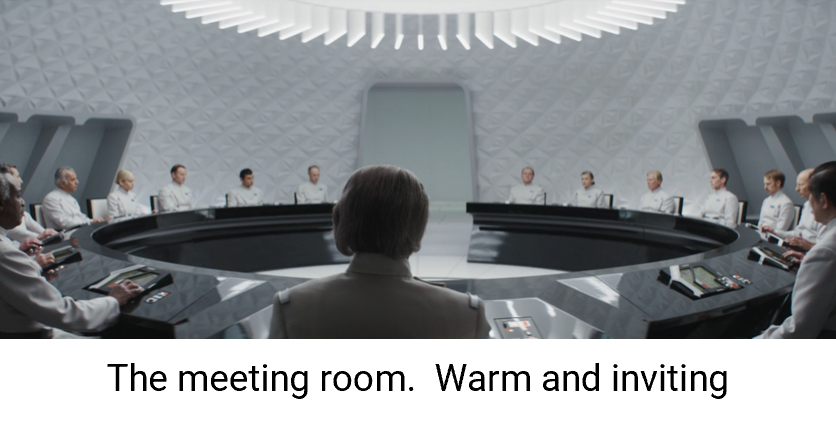Star Wars Can Teach Us About Org Structure?
This time I go through a scene from the TV show Andor…so it’s better to watch me do this on video. To do that, click here.
And if you can’t…I’ll go through it now.
Have you seen the show Andor? I’ll bet you didn’t know there’s a lesson in there about organisational structure!
The show is part of the Star Wars pantheon, but it’s different. Deeper, and goes right into the effects of colonisation, imperialism and how that can turn individuals.
And…we get to see what’s called the Imperial Security Bureau in action, which we can picture as an Executive Team of an organisation. Here they are:
The scene I go through is a meeting of the ‘Supervisors’, who are the equivalent to Executives, with the boss being Major Partagaz who we might say is the CEO.
The Scene
Earlier, Supervisor Meero had a hunch that there was a pattern in the data, and requested information from the sector (division) of Supervisor Blevin, which he rejected. After a further incident, Meero used an Emergency Act to go around Blevin and get the information anyway.
In the clip, Blevin raises his charge in front of the team, of course in the interests of security…
…that Meero had breached the code of conduct and brought danger to the team.
Standard political move right? We feel our power and authority has been threatened, so we lean on rules and protocols instead of just arriving say “I’m annoyed”.
The charge is put to Meero (who is the only woman in the leadership room, so things aren’t that different on other planets), and she effectively responds with……yep…I did do that after the huge security breach the other day.
Customers Don’t Care
And then she says:
“but that is the wrong question”.
After a perfect pause, she then says:
“I’d like to know if anyone here believes the Rebellion plans its actions around the artificially constructed boundaries of sectors.”
Let me change three words:
“I’d like to know if anyone here believes CUSTOMERS plan their actions around the artificially constructed DIVISIONS of our ORGANISATION.”
This is the key point.
Customers don’t care about how we organise the work internally. They are not purchasing your org chart to improve their existence.
Not Playthings
The scene goes on – when an older white male looks to shut things down (surprised?) by pointing out that it was Major Partagaz (our CEO here) who created the sectors, Meero responds..
“as organising principles, not personal playthings”.
Another key point.
The whole point of divisions is to organise the work. We handle complexity by dividing up responsibilities so, if everyone does their thing and we stay integrated…we can get things done as a whole.
They are not put together to give Executives independent empires to play with.
Feels that way though, doesn’t it!
Lines on Maps
Meero even makes her point again
“Do you really think the Rebels care about the lines we draw on maps”
…or as we might put it…
“Do you really thing CUSTOMERS care about the lines we draw on our ORG CHART?”
When Partagaz himself asks Meero whether she thinks what he place has been supplanted, she responds:
“Systems either change or die”.
Now that’s a mic drop!
What can we get from this?
1. Divisions let us handle a complex environment.
‘Divide and conquer’ isn’t about how to dominate a group, it’s about the principles of handling a complex situation where a lot of expertise is going to need to come together – we divide the work so we can handle the situation.
The key here, however, is that we stay connected while we do so. Which is often the issue more than the structure, which takes us to:
2. Physiotherapy before surgery
Issues around the table often create a call for a restructure. But changing structure is surgery – sometimes necessary, but is going to require a recovery period, and cannot be guaranteed to be successful. If we can treat an injury with physiotherapy, this can be a much more effective intervention due to being less invasive.
The issue in the scene wasn’t the structure, it was Blevin’s reaction to having information gained from his area that he didn’t want to give. It was the way Blevin and Meero were working together that was the problem. This needs physio – addressing of the relationship itself. At least first.
3. Super-ordinate goal
The clip also reminds us of the importance of the super-ordinate goal – the goal that sits above any one area. You could call it the team goal. In this case it’s the security of the empire. Meero was seeing events in different sectors that may have been a pattern, so she wanted information from more than her own sector. A discussion on the overall goal of the team, rather than on how turf is supposed to work, would have been a lot more valuable use of time.
Bringing it Home
Structure is there to organise work. To become a successful leader, the work is to see it as nothing more than that, and act in a way that recognises that any one division is just a part.
To act otherwise is treating divisions and departments as a personal playthings. Which is exactly not the point.
And above all, remember, the customers don’t care how you organise things. They care about getting the value they were promised.
Now, over to you.





